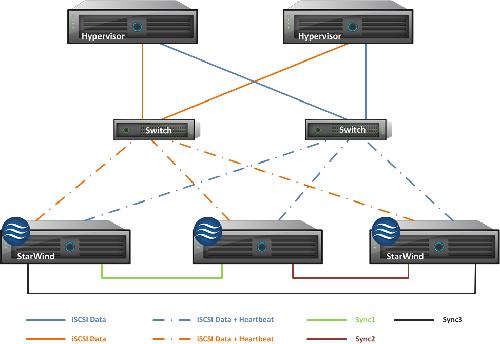
Therefore, you need to thoroughly analyze your workload profile and make a call. However, it comes with slight performance penalty for WRITE operations.

Thus, the disk spindles of all Virtual SAN servers will be servicing READ requests. Basically, it is like RAID-10 over network. There are also some blog posts and StarWind white papers stating that Round Robin can significantly improve READ operations as ESXi host will talk to both SW VSAN servers evenly distributing the load.
#Starwind iscsi psp
This is the only supported PSP when running Virtual SAN on ESXi according to StarWind Virtual SAN Best Practices document. With Fixed your ESXI host always talks to the locally hosted Virtual SAN servers unless it fails and then all iSCSI paths are switched to the SW VSAN hosted on the second ESXi server. Basically I can see two options here and your choice depends on what Path Selection Protocol (PSP) you choose: Fixed or Round Robin. Now let's go back to iSCSI multipathing choice. Heartbeat traffic can also be co-exist with other types of networks, e.g. If you want to save your company some bucks you could just use a pair of crossover links. Therefore, it is very important to keep SYNC and Heartbeat traffic on separate set of physical NICs and physical switches. When StarWind node fails to contact its HA partner via Synchronization network it will try to reach its partner node using heartbeat network. Heartbeat Network is used to avoid split-brain scenarios. There is slightly different networking configuration for Round-Robin and Fixed multipathing. Remote iSCSI network - this network allows the ESXi host to communicate with SW VSAN on another ESXi host in case the local Virtual SAN server fails. Local iSCSI network - that where the ESXi host talks to the locally hosted SW Virtual SAN b. For HA scenarios there always have to be at least two iSCSI networks per host:Ī. iSCSI network - that's where the actual iSCSI packets are exchanged between ESXi hosts (iSCSI Initiators) and StarWind Virtual SAN (iSCSI Targets). That makes perfect sense since every single packet sent by the ESXi host to the local virtual Virtual SAN server has to be mirrored to another Virtual SAN server.ģ. According to the best practices document the total bandwidth of all SYNC interfaces should be at least equal to the sum of iSCSI throughput between ESXi hosts and StarWind servers.

Synchronization network is used to mirror storage data between StarWind Virtual SAN appliances. VM Network - that's where you connect the management interface of your Virtual SAN servers.Ģ. Let's briefly explain what each type of the network does:ġ. Let's have a look at standard diagram of SW HA solution running on 2 x ESXi servers.Īs you can see there are 4 different types of networks required by Virtual SAN. Configuration of storage and networking for Hyper-V or Xen Server may noticeably differ. Please note that I am reviewing hyperconverged scenario with StarWind virtual servers running on top of ESXi servers.


 0 kommentar(er)
0 kommentar(er)
